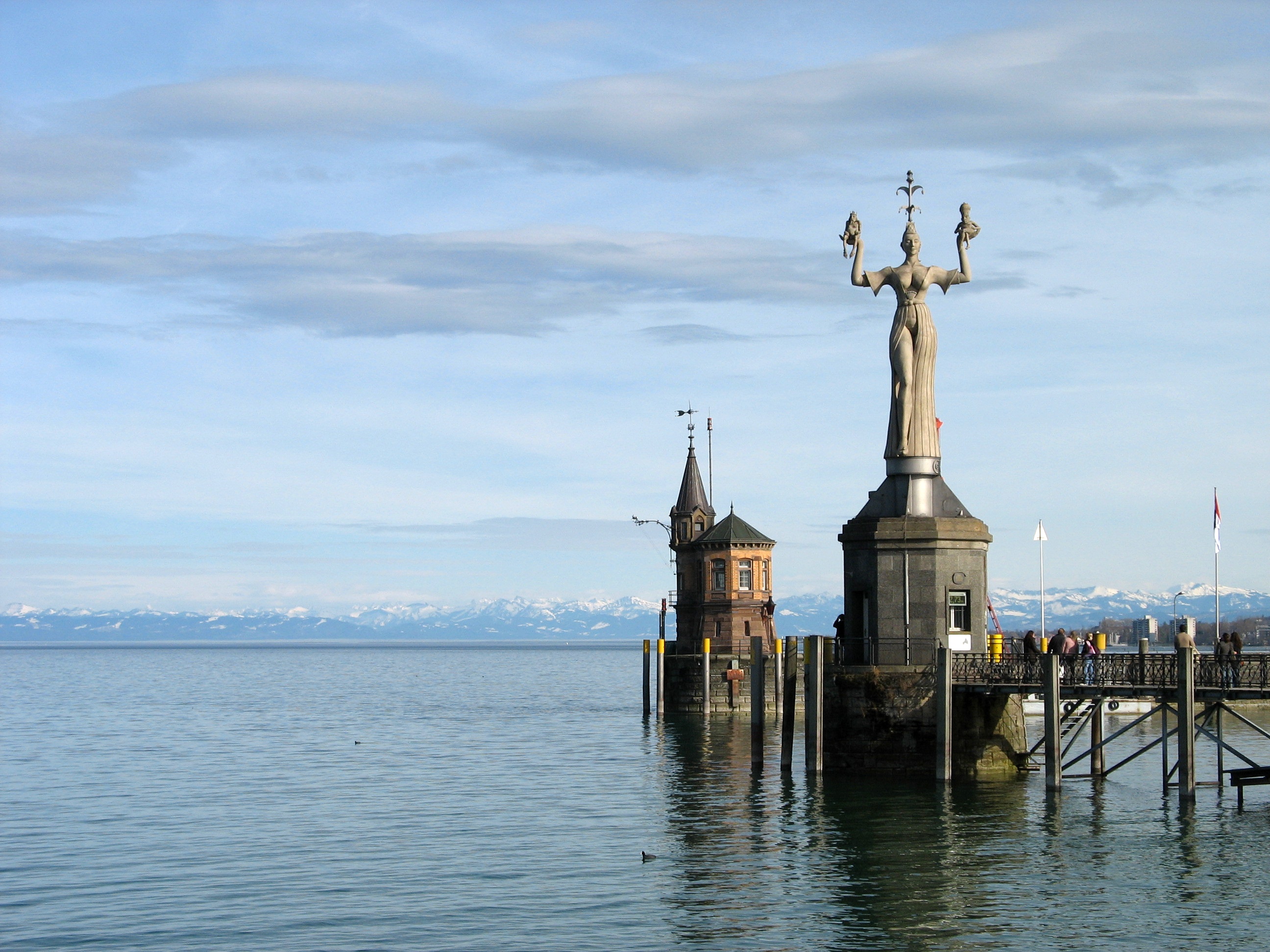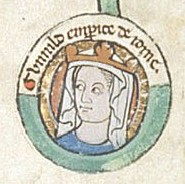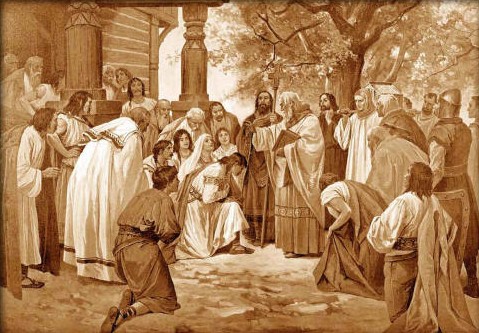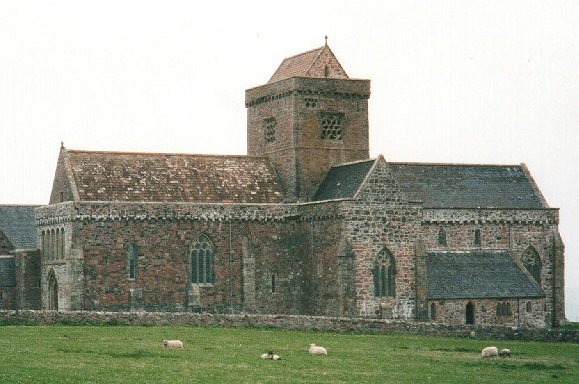|
Peace And Truce Of God
The Peace and Truce of God ( lat, Pax et treuga Dei) was a movement in the Middle Ages led by the Catholic Church and one of the most influential mass peace movements in history. The goal of both the ''Pax Dei'' and the ''Treuga Dei'' was to limit the violence of feuding endemic to the western half of the former Carolingian Empire – following its collapse in the middle of the 9th century – using the threat of spiritual sanctions. The eastern half of the former Carolingian Empire did not experience the same collapse of central authority, and neither did England. The Peace of God was first proclaimed in 989, at the Council of Charroux. It sought to protect ecclesiastical property, agricultural resources and unarmed clerics. The Truce of God, first proclaimed in 1027 at the Council of Toulouges, attempted to limit the days of the week and times of year that the nobility engaged in violence. The movement survived in some form until the thirteenth century. Other strategies to ... [...More Info...] [...Related Items...] OR: [Wikipedia] [Google] [Baidu] |
Middle Ages
In the history of Europe, the Middle Ages or medieval period lasted approximately from the late 5th to the late 15th centuries, similar to the post-classical period of global history. It began with the fall of the Western Roman Empire and transitioned into the Renaissance and the Age of Discovery. The Middle Ages is the middle period of the three traditional divisions of Western history: classical antiquity, the medieval period, and the modern period. The medieval period is itself subdivided into the Early, High, and Late Middle Ages. Population decline, counterurbanisation, the collapse of centralized authority, invasions, and mass migrations of tribes, which had begun in late antiquity, continued into the Early Middle Ages. The large-scale movements of the Migration Period, including various Germanic peoples, formed new kingdoms in what remained of the Western Roman Empire. In the 7th century, North Africa and the Middle East—most recently part of the Eastern Ro ... [...More Info...] [...Related Items...] OR: [Wikipedia] [Google] [Baidu] |
Germania (book)
The ''Germania'', written by the Roman historian Publius Cornelius Tacitus around 98 AD and originally entitled ''On the Origin and Situation of the Germans'' ( la, De origine et situ Germanorum), is a historical and ethnographic work on the Germanic peoples outside the Roman Empire. Contents The ''Germania'' begins with a description of the lands, laws, and customs of the Germanic people (chapters 1–27); it then describes individual peoples, beginning with those dwelling closest to Roman lands and ending on the uttermost shores of the Baltic, among the amber-gathering Aesti, the Fenni, and the unknown peoples beyond them. Tacitus says (chapter 2) that physically, the Germanic peoples appear to be a distinct nation, not an admixture of their neighbors, since nobody would desire to migrate to a climate as horrid as that of Germania. They are divided into three large branches, the Ingaevones, the Irminones, and the Istaevones, deriving their ancestry from three sons of Man ... [...More Info...] [...Related Items...] OR: [Wikipedia] [Google] [Baidu] |
Konstanz
Konstanz (, , locally: ; also written as Constance in English) is a university city with approximately 83,000 inhabitants located at the western end of Lake Constance in the south of Germany. The city houses the University of Konstanz and was the residence of the Roman Catholic Diocese of Konstanz for more than 1,200 years. Location The city is located in the state of Baden-Württemberg and situated at the banks of Lake Constance (''Bodensee'' in German). The river Rhine, which starts in the Swiss Alps, passes through Lake Constance and leaves it, considerably larger, by flowing under a bridge connecting the two parts of the city. North of the river lies the larger part of the city with residential areas, industrial estates, and the University of Konstanz; while south of the river is the old town, which houses the administrative centre and shopping facilities in addition to the ''Hochschule'' or the ''University of Applied Sciences''. Car ferries provide access across Lake Con ... [...More Info...] [...Related Items...] OR: [Wikipedia] [Google] [Baidu] |
Holy Roman Emperor Henry III
Henry III (28 October 1016 – 5 October 1056), called the Black or the Pious, was Holy Roman Emperor from 1046 until his death in 1056. A member of the Salian dynasty, he was the eldest son of Conrad II and Gisela of Swabia. Henry was raised by his father, who made him Duke of Bavaria in 1026, appointed him co-ruler in 1028 and bestowed him with the duchy of Swabia and the Kingdom of Burgundy ten years later in 1038. The emperor's death the following year ended a remarkably smooth and harmonious transition process towards Henry's sovereign rule, that was rather uncharacteristic for the Ottonian and Salian monarchs. Henry succeeded Conrad II as Duke of Carinthia and King of Italy and continued to pursue his father's political course on the basis of ''virtus et probitas'' (courage and honesty), which led to an unprecedented sacral exaltation of the kingship. In 1046 Henry ended the papal schism, was crowned Emperor by Pope Clement II, freed the Vatican from dependence on the Roman ... [...More Info...] [...Related Items...] OR: [Wikipedia] [Google] [Baidu] |
Normans
The Normans (Norman language, Norman: ''Normaunds''; french: Normands; la, Nortmanni/Normanni) were a population arising in the medieval Duchy of Normandy from the intermingling between Norsemen, Norse Viking settlers and indigenous West Francia, West Franks and Gallo-Roman culture, Gallo-Romans. The term is also used to denote emigrants from the duchy who conquered other territories such as England and Sicily. The Norse settlements in West Francia followed a series of raids on the French northern coast mainly from Denmark, although some also sailed from Norway and Sweden. These settlements were finally legitimized when Rollo, a Scandinavian Viking leader, agreed to swear fealty to Charles the Simple, King Charles III of West Francia following the Siege of Chartres (911), siege of Chartres in 911. The intermingling in Normandy produced an Ethnic group, ethnic and cultural "Norman" identity in the first half of the 10th century, an identity which continued to evolve over the ce ... [...More Info...] [...Related Items...] OR: [Wikipedia] [Google] [Baidu] |
Vikings
Vikings ; non, víkingr is the modern name given to seafaring people originally from Scandinavia (present-day Denmark, Norway and Sweden), who from the late 8th to the late 11th centuries raided, pirated, traded and settled throughout parts of Europe.Roesdahl, pp. 9–22. They also voyaged as far as the Mediterranean, North Africa, Volga Bulgaria, the Middle East, and North America. In some of the countries they raided and settled in, this period is popularly known as the Viking Age, and the term "Viking" also commonly includes the inhabitants of the Scandinavian homelands as a collective whole. The Vikings had a profound impact on the early medieval history of Scandinavia, the British Isles, France, Estonia, and Kievan Rus'. Expert sailors and navigators aboard their characteristic longships, Vikings established Norse settlements and governments in the Viking activity in the British Isles, British Isles, the Faroe Islands, Settlement of Iceland, Icela ... [...More Info...] [...Related Items...] OR: [Wikipedia] [Google] [Baidu] |
Knight
A knight is a person granted an honorary title of knighthood by a head of state (including the Pope) or representative for service to the monarch, the church or the country, especially in a military capacity. Knighthood finds origins in the Greek ''hippeis'' and '' hoplite'' (ἱππεῖς) and Roman '' eques'' and ''centurion'' of classical antiquity. In the Early Middle Ages in Europe, knighthood was conferred upon mounted warriors. During the High Middle Ages, knighthood was considered a class of lower nobility. By the Late Middle Ages, the rank had become associated with the ideals of chivalry, a code of conduct for the perfect courtly Christian warrior. Often, a knight was a vassal who served as an elite fighter or a bodyguard for a lord, with payment in the form of land holdings. The lords trusted the knights, who were skilled in battle on horseback. Knighthood in the Middle Ages was closely linked with horsemanship (and especially the joust) from its origins in th ... [...More Info...] [...Related Items...] OR: [Wikipedia] [Google] [Baidu] |
Christianity In The 9th Century
In 9th-century Christianity, Charlemagne was crowned as Holy Roman Emperor, which continued the Photian schism. Carolingian Renaissance On Christmas day in 800, the Roman Patriarch Leo III crowned Charles, the eldest son of Pepin the Short, as the "Holy Roman Emperor," in essence denying the status of the Byzantine Empress Irene, reigning in Constantinople. This act caused a substantial diplomatic rift between the Franks and Constantinople, as well as between Rome and the other patriarchs in the East. Though the rifts were settled to some degree and the Church in Rome in theory remained united with Constantinople and the rest of the imperial church, paths culminating in the Great Schism. With Charlemagne's coronation, the papacy had acquired a new protectorate in the West. This freed the pontiffs to some degree from the power of the emperor in Constantinople but also led to a schism, because the emperors and patriarchs of Constantinople interpreted themselves as the true ... [...More Info...] [...Related Items...] OR: [Wikipedia] [Google] [Baidu] |
Carolingian Empire
The Carolingian Empire (800–888) was a large Frankish-dominated empire in western and central Europe during the Early Middle Ages. It was ruled by the Carolingian dynasty, which had ruled as kings of the Franks since 751 and as kings of the Lombards in Italy from 774. In 800, the Frankish king Charlemagne was crowned emperor in Rome by Pope Leo III in an effort to transfer the Roman Empire from Byzantine Empire to Europe. The Carolingian Empire is considered the first phase in the history of the Holy Roman Empire. After a civil war (840–843) following the death of Emperor Louis the Pious, the empire was divided into autonomous kingdoms, with one king still recognised as emperor, but with little authority outside his own kingdom. The unity of the empire and the hereditary right of the Carolingians continued to be acknowledged. In 884, Charles the Fat reunited all the Carolingian kingdoms for the last time, but he died in 888 and the empire immediately split up. With the only r ... [...More Info...] [...Related Items...] OR: [Wikipedia] [Google] [Baidu] |
Cáin Adomnáin
The ''Cáin Adomnáin'' (Law of Adomnán), also known as the ''Lex Innocentium'' (Law of Innocents), was promulgated amongst a gathering of Irish, Dál Riatan and Pictish notables at the Synod of Birr in 697. It is named after its initiator Adomnán of Iona, ninth Abbot of Iona after St. Columba. It is called the "Geneva Accords" of the ancient Irish and Europe's human rights treaty, for its protection of women and non-combatants, extending the Law of Patrick, which protected monks, to civilians. The legal symposium at the Synod of Birr was prompted when Adomnáin had an Aisling dream vision wherein his mother excoriated him for not protecting the women and children of Ireland. History During almost two centuries, and more precisely the years 697-887, nine different ordinances were promulgated and kept in the record of the annals of Ireland. Each ordinance was issued either by a saint or monastic group. Three texts of these legislations have come to us, the earliest being C ... [...More Info...] [...Related Items...] OR: [Wikipedia] [Google] [Baidu] |
Adomnán
Adomnán or Adamnán of Iona (, la, Adamnanus, Adomnanus; 624 – 704), also known as Eunan ( ; from ), was an abbot of Iona Abbey ( 679–704), hagiographer, statesman, canon jurist, and saint. He was the author of the ''Life of Columba'' ( la, Vita Columbae), probably written between 697 and 700. This biography is by far the most important surviving work written in early-medieval Scotland, and is a vital source for our knowledge of the Picts, and an insight into the life of Iona and the early-medieval Gaelic monk. Adomnán promulgated the Law of Adomnán or "Law of Innocents" ( la, Lex Innocentium). He also wrote the treatise ('On Holy Places'), an account of the great Christian holy places and centres of pilgrimage. Adomnán got much of his information from a Frankish bishop called Arculf, who had personally visited Egypt, Rome, Constantinople and the Holy Land, and visited Iona afterwards. Life Adomnán was born about 624, a relative on his father's side of C ... [...More Info...] [...Related Items...] OR: [Wikipedia] [Google] [Baidu] |
Pax Romana
The Pax Romana (Latin for 'Roman peace') is a roughly 200-year-long timespan of Roman history which is periodization, identified as a period and as a golden age (metaphor), golden age of increased as well as sustained Imperial cult of ancient Rome, Roman imperialism, relative peace and order, prosperous stability, Regional hegemony, hegemonial power, and Roman expansion, regional expansion, despite several List of Roman civil wars and revolts, revolts and List of Roman wars and battles, wars, and Roman–Persian Wars, continuing competition with Parthia. It is traditionally dated as commencing from the accession of Augustus, founder of the Roman principate, in 27 BC and concluding in 180 AD with the death of Marcus Aurelius, the last of the "Five Good Emperors". Since it was inaugurated by Augustus at the end of the War of Actium, final war of the Roman Republic, it is sometimes also called the Pax Augusta. During this period of about two centuries, the Roman Empire achieved its gre ... [...More Info...] [...Related Items...] OR: [Wikipedia] [Google] [Baidu] |








